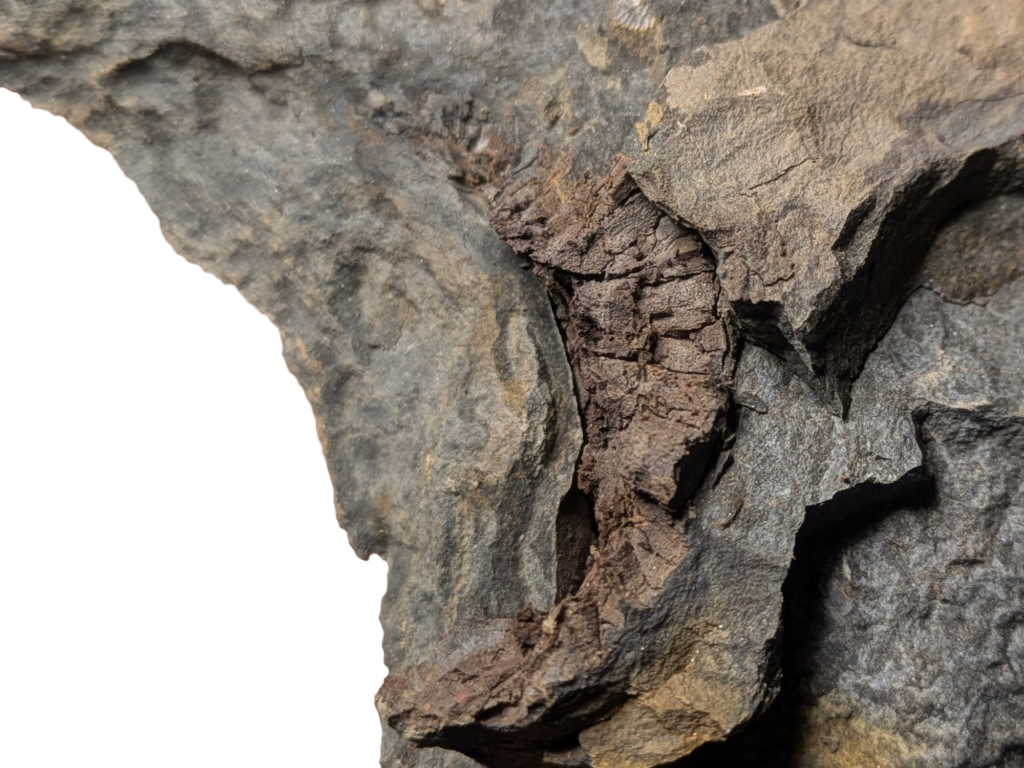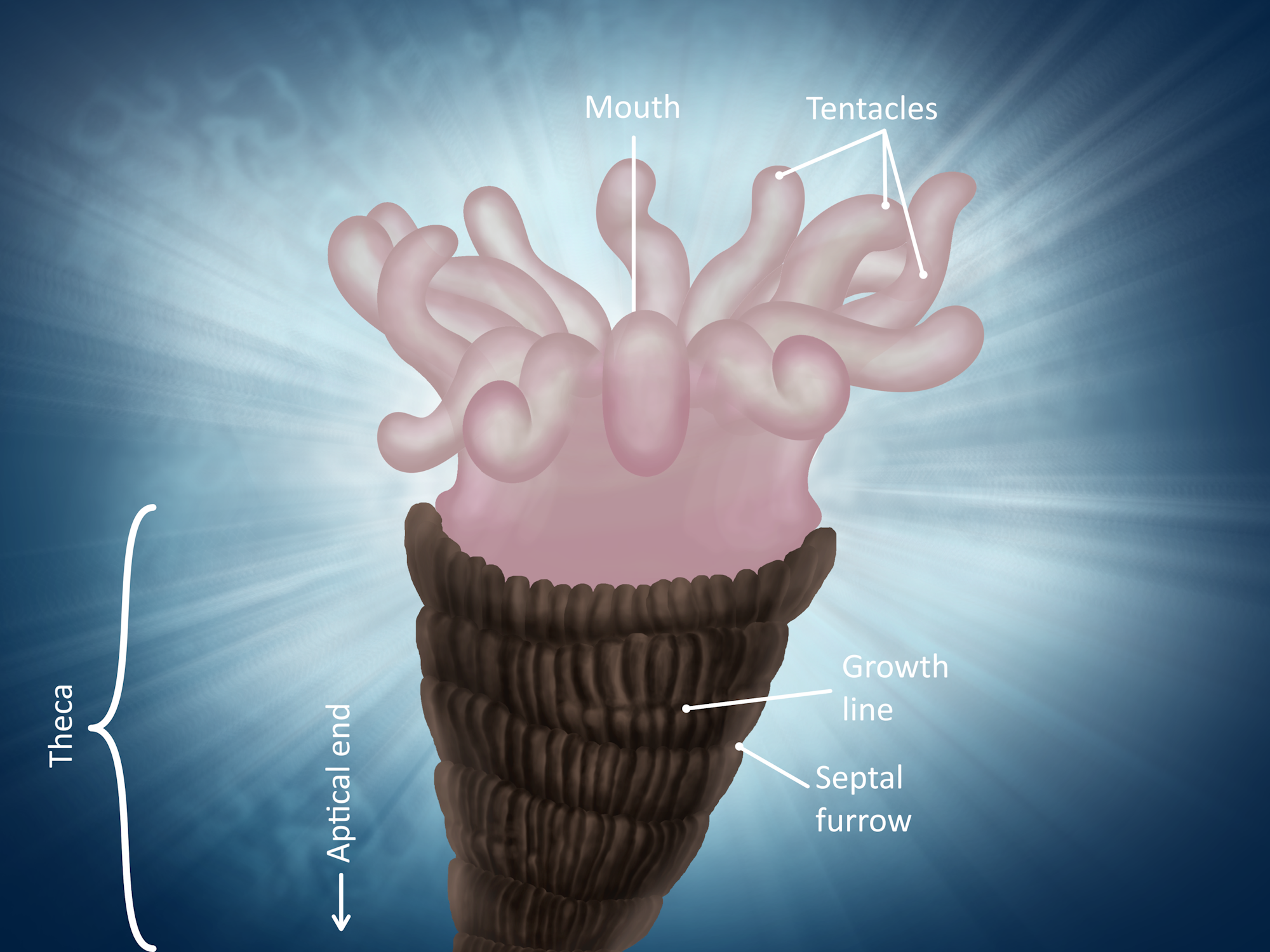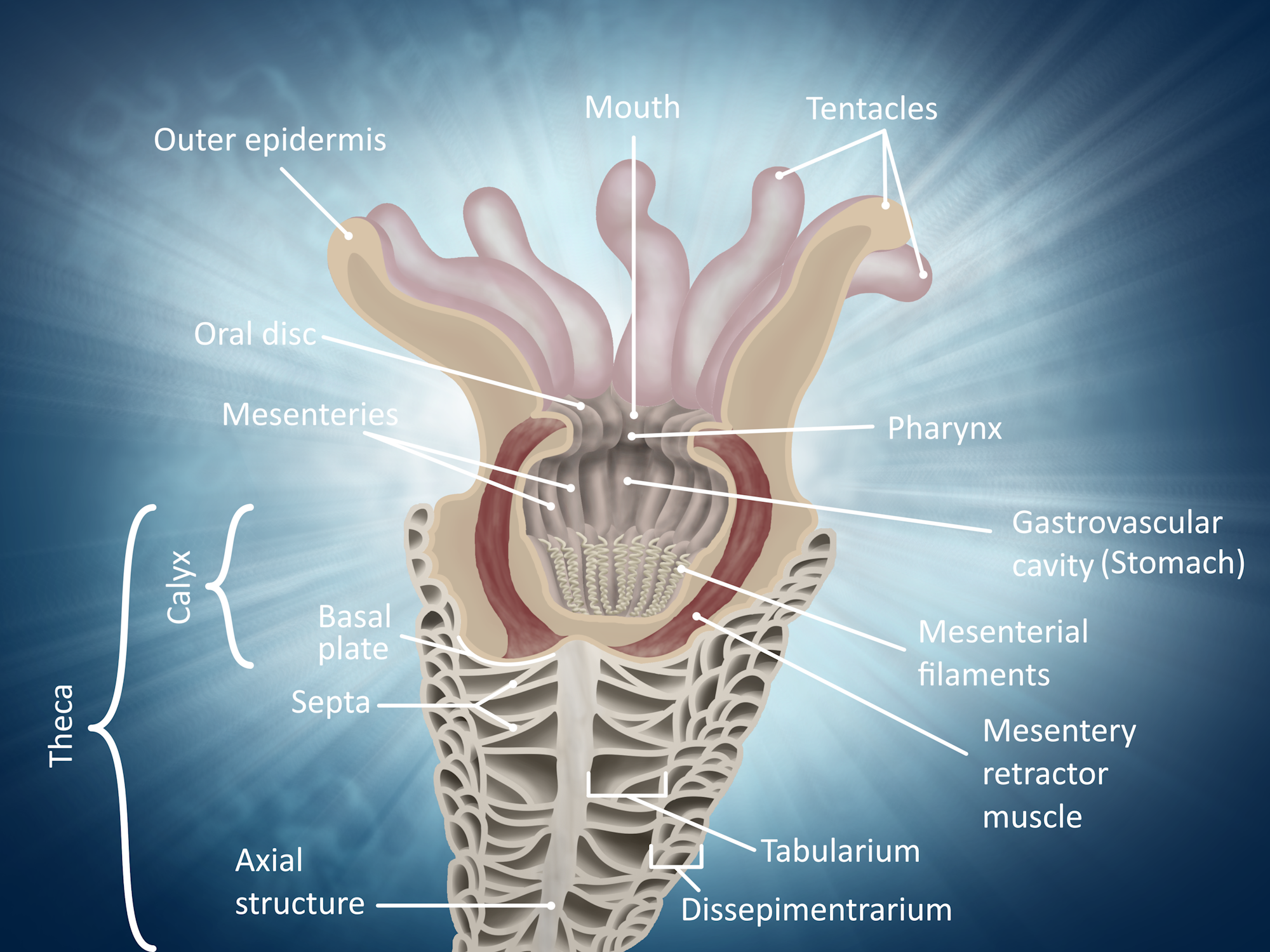
Anthozoans, or corals, are a diverse group of cnidarians that build complex living structures out of calcium. They are incredibly successful, having about 1500 living species today. Each individual coral animal is called a polyp; these can be either colonial or solitary. They filter feed with numerous stinging tentacles and represent one of the most important life forms in modern shallow seas, as their skeletons provide food and shelter for millions of other marine organisms (3) .
Anthozoans found at Seven Stars

Pleurodictyum americanum
COMMON

Stereolasma rectum
VERY RARE
How do I identify Anthozoans?
Corals are a rare find at Seven Stars, but are pretty easy to identify once they are found. There are only two kinds of coral at Seven Stars, both part of very different groups and very distinct from all other fossils at the site. Pleurodictyum americanum was a tabulate coral (Subclass Tabulata), forming medium-sized colonies. These are often preserved as iron-rich internal molds, and resemble rough geodes as they are often found. Sometimes, the original coralites are preserved, with the spaces in between the polyps filled in with white minerals. If one looks closely at the internal mold of a Pleurodictyum polyp, tiny pores can be observed.
Unlike Pleurodictyum, Stereolasma rectum was a solitary Rugose coral. Rugose corals (Subclass Rugosa) were very different from tabulate corals in many ways. Most, but not all, rugose corals were solitary and they lacked the tabulae (see diagram below) that characterized tabulate corals. They also had very well developed septa, which were vertical, wall-like growths that extended from the center of the coralite and provided the polyp with structural support (1). While tabulate corals also bore septa, they were very small and were not well developed (2).
Stereolasma individuals grew much larger than Pleurodictyum polyps, but much smaller than entire colonies of Pleurodictyum. Stereolasma can grow between 1-2cm long, and when found, usually suffers bad preservation. Often they can only be recognised by their straight cone shape, not appearing spiraled as the Gastropod Palaeozygopleura. One specimen that has been collected bears the well-developed septa that are common in rugose corals, but other specimens do not preserve this detail or they are covered in matrix.

What were Anthozoans?
Anthozoans, or coral, are among the most famous and ecologically important marine organisms, found in shallow reefs worldwide. While corals are represented today only by the group Scleractinia, the tabulate and rugose corals were very common in the Early Paleozoic, and survived until the Permo-Triassic Extinction (1,2,3). These groups used calcite to build their shells, while the modern Scleractinian corals use aragonite (3), the form of calcite also used by many mollusks (see Gastropoda, Monoplacophora, and Cephalopoda). Because each group of corals is so different, we will dive into each group separately for the least confusion. Scleractinia will be skipped, because it is not found at Seven Stars, but you can learn more about it here.
Rugosa (rugose corals)
Rugose corals can be either solitary or colonial, but most were solitary. They built cone-shaped skeletons that expanded as the coral grew. Septa within the calice (where the polyp lived) partitioned off older parts of the skeleton, while offering extra support for the living animal (1). The soft anatomical features of rugose corals are unknown, due to their decomposition during the fossilization process. It is assumed that they had similar anatomy to today’s Scleractinian corals, which have many stinging tentacles lining the mouth, which is central and can open and close by constriction. The mouth is the sole opening to the inner polyp, so in addition to food particles entering here, waste is excreted from the mouth as well. Corals feed from particles suspended in the water column, ingesting plankton and calcium from the water with which to build their skeletons (1).
Remarkably, scientists have been able to use rugose corals’ growth patterns to make inferences about the Earth in Paleozoic times. In particular, Early to Middle Devonian rugose corals that lived in similar environments to Seven Stars preserve their growth lines in enough detail that they can be counted and the seasons that they were added to the skeleton can be inferred based on patterns in modern coral growth. Meticulously counting these, Paleontologists predicted that in the Devonian Period, there were 410-395 per year instead of the modern 365.25, and that each day had only around 22 hours in it, due to the moon’s pull on the Earth as it spins (1). For the Givetian Stage of the Devonian, when the organisms that lived at Seven Stars were fossilized, there were between 402 and 403 days per year and each had just under 22 hours in it (4).
Tabulata (tabulate corals)
Tabulate corals were colonial, often forming medium to large-sized colonies. Unlike modern Scleractinian corals, they did not usually compose the majority of the reef, though they were likely obvious members of it. Amazing fossils from Nunavut, Canada, have been found, being preserved only because of rare conditions. These fossils preserve various tissues from a Favositid tabulate coral, Heliolites, showing that it had (like Scleractinian corals) a central mouth, and either 12 or 24 tentacles, based on pointed, rod-shaped structures called spicules preserved within the coralite (6). An earlier author, Copper (1985), reported finding Favosites with 11, 12, or 13, but usually 12, calcified tentacles (2). These served to confirm that Tabulata were indeed Anthozoans (some authors had questioned this placement prior to this discovery) (2, 6). The spicules in Heliolites are thought to have been used as muscle attachments, being homologous to the mesenteries (fleshy extensions of the septa) of Scleractinian corals. They either helped the coral flex its tentacles, or they served to help the coral retract into its coralite. This is the preferred hypothesis, and is supported by the slight overlapping of the spicules (it would be strange for the spicules to overlap one another if they were muscle attachments for the tentacles). Because the spicules overlap radially, the living polyp likely swiveled its body as it retracted into the coralite, so that the spicules would overlap more (6).
Being a Favositid, Pleurodictyum americanum likely had a similar anatomy to the Canadian fossils. It can be inferred that Pleurodictyum had 12 tentacles, and spicules within its mesenteries.
Modern Scleractinian corals have a photosymbiotic relationship with zooxanthellae, algae that live inside the coral’s tissues to provide the polyp with energy from the sun. In return, the coral gives the zooxanthellae shelter and protection from other organisms. The algae also enable the coral to secrete its rocky skeleton, and they leave traces of 18O and 13C behind (2, 8).
Zapalski (2014) found very similar isotopes of oxygen and carbon in four major different Paleozoic coral groups, and found that tabulate corals likely started hosting zooxanthellae in the Silurian Period, about 430 MA. Many Favositids, the group that includes Pleurodictyum, had these isotopic values, so Pleurodictyum likely had a photosymbiotic relationship with zooxanthellae, allowing it to grow and giving it vivid colors (2, 8).
Anthozoans at Seven Stars
Both species of coral at Seven Stars are not very easy to find, but suggest (along with the other filter feeders at the site) that Seven Stars was a good source of planktonic life. They are often badly preserved, but likely were bright spots of color in an otherwise dull landscape.
Pleurodictyum americanum
Pleurodictyum colonies are usually preserved overturned, with the bases of the coralites reaching in towards the center. In coastal areas, this coral is often dome shaped, while more offshore populations are flatter and less dome shaped. This is thought to be simply the result of different genes being more common in different regions, instead of being a result of differences in environment, because dome shaped corals can be found in offshore environments and vice versa (7).

It is difficult to judge the shape of most Pleurodictyum colonies at Seven Stars, because they are mostly preserved upside down. However, the lower specimen at right displays an apparent curvature that may suggest that Seven Stars could be classified as a near shore environment.

Stereolasma rectum
Stereolasma was a solitary coral, with each coralite living on its own. Each polyp was larger than that of Pleurodictyum; when individual coralites of Pleurodictyum (broken off from the main colony during taphonomy) are found, they can be differentiated from Stereolasma because they are covered in pores. Stereolasma is often badly preserved, with its internal radiating septa being obscured by both the level of preservation and the surrounding matrix. This coral grows from 1-2 cm in length. Very few specimens (2 or 3) have been recovered from Seven Stars.

Works cited
(1) Hendricks, Jonathan R. “1.2 Rugose Corals (Rugosa) | Digital Atlas of Ancient Life.” Digital Atlas of Ancient Life.org, Paleontological Research Institution, 1 Nov. 2019. Accessed 20 Dec. 2023.
https://www.digitalatlasofancientlife.org/learn/cnidaria/anthozoa/rugosa/
(2) Hendricks, Jonathan R. “1.3 Tabulate corals (Tabulata) | Digital Atlas of Ancient Life.” digitalatlasofancientlife.org, Paleontological Research Institution, 1 Nov. 2019. Accessed 20 Dec. 2023.
https://www.digitalatlasofancientlife.org/learn/cnidaria/anthozoa/tabulata/
(3) Hendricks, Jonathan R. “1.1 Scleractinia | Digital Atlas of Ancient Life.” digitalatlasofancientlife.org, Paleontological Research Institution, 1 Nov. 2019. Accessed 20 Dec. 2023.
https://www.digitalatlasofancientlife.org/learn/cnidaria/anthozoa/scleractinia/
(4) kpanchuk. (2019) Fossils of the Paleozoic: Phylum Cnidaria (the Corals). Pressbooks. Accessed 20 Dec. 2023
https://pressbooks.bccampus.ca/earthhistorylab/chapter/fossils-of-the-paleozoic/
(5) de Winter, Niels & Goderis, Steven & Van Malderen, Stijn & Sinnesael, Matthias & Vansteenberge, Stef & Snoeck, Christophe & Belza, J. & Vanhaecke, Frank & Claeys, Philippe. (2020). Subdaily‐Scale Chemical Variability in a Torreites Sanchezi Rudist Shell: Implications for Rudist Paleobiology and the Cretaceous Day‐Night Cycle. Paleoceanography and Paleoclimatology. 35. e2019PA003723. 10.1029/2019PA003723.
https://agupubs.onlinelibrary.wiley.com/doi/full/10.1029/2019PA003723
(6) Dixon, O.A. 2010: Fossilized polyp remains in Silurian Heliolites (Anthozoa, Tabulata) from Nunavut, Arctic Canada. Lethaia, Vol. 43, pp. 60–72.
https://www.idunn.no/doi/pdf/10.1111/j.1502-3931.2009.00173.x
(7) Pandolfi, J. & Burke, Collette. (2007). Environmental distribution of colony growth form in the favositid Pleurodictyum americanum. Lethaia. 22. 69 – 84. 10.1111/j.1502-3931.1989.tb01170.x.
(8) Zapalski, Mikolaj. (2014). Evidence of photosymbiosis in Palaeozoic tabulate corals. Proceedings. Biological sciences / The Royal Society. 281. 20132663. 10.1098/rspb.2013.2663.
(9) Jung, Jonathan & Zoppe, Simon & Söte, Till & Moretti, Simone & Duprey, Nicolas & Foreman, Alan & Wald, Tanja & Vonhof, Hubert & Haug, Gerald & Sigman, Daniel & Schindler, Eberhard & Janussen, Dorte & Martínez-García, Alfredo. (2023). Coral Photosymbiosis on Mid-Devonian Reefs. 10.21203/rs.3.rs-3265285/v1.
https://www.researchgate.net/publication/373347184_Coral_Photosymbiosis_on_Mid-Devonian_Reefs


